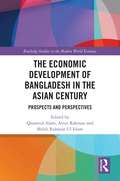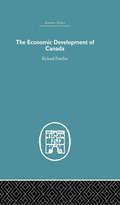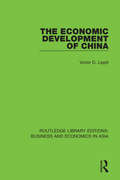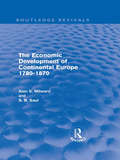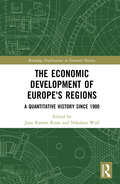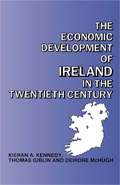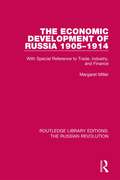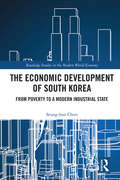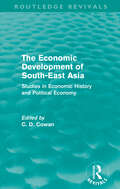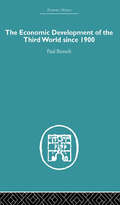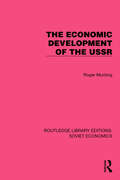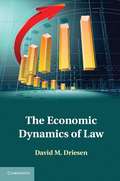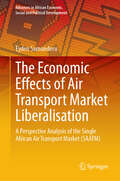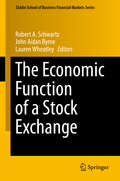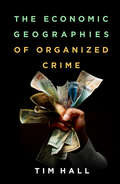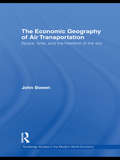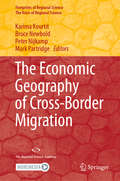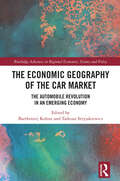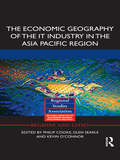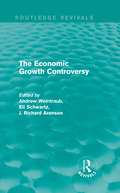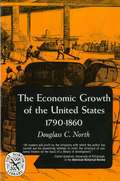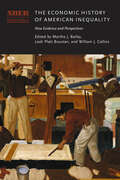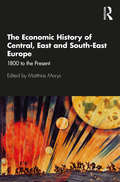- Table View
- List View
The Economic Development of Bangladesh in the Asian Century: Prospects and Perspectives (Routledge Studies in the Modern World Economy)
by Quamrul Alam, Atiur Rahman and Shibli Rubayat Ul IslamThis book explains the macro-drivers of growth behind the economic development of Bangladesh. Few countries in the developing world have shown as exciting a promise of economic prosperity as Bangladesh. The promising nature of the Bangladeshi economy raises interesting questions pertaining to whether good governance may lead to sustained economic growth. This book looks at the strategic interventions on macro-level, specifically the policy interventions. This book will be a useful reference to making sense how economic transformation can be strengthened through state-sponsored activities and how states can inculcate a culture of innovation which can be regarded as one of the underpinnings of economic growth.
The Economic Development of Canada
by Richard PomfretFirst Published in 2005. Routledge is an imprint of Taylor & Francis, an informa company.
The Economic Development of China (Routledge Library Editions: Business and Economics in Asia #9)
by Victor D. LippitThis book, first published in 1987, studies the forces promoting underdevelopment in China prior to 1949 and the character of the development that has occurred since then. It presents a unified perspective for grasping the development process as a whole, for relating this to the class structure of China, and for considering development in the context of Chinese efforts to carry out a transition to socialism.
The Economic Development of Continental Europe 1780-1870 (Routledge Revivals)
by Alan Milward S. B. SaulUpon its initial publication in 1973 this was the first textbook to present a unified view and comprehensive treatment of the economic development of Europe from a continental rather than a British perspective. At the same time, it is more than mere textbook: it is an interpretive analysis of a wide range of research on the subject in many countries which explores the objective validity of earlier theories and provides an ideal starting point for further research into economic development and European history. The work deals mainly with Western Europe, but in principally studying both France and Germany up to 1870 the authors by no means neglect the smaller countries. Indeed, the work is unusual in dealing fully with the Scandinavian countries and others, such as Switzerland and Belgium. This is a reissue of the fully revised and corrected second edition of the work, first published in 1979.
The Economic Development of Europe's Regions: A Quantitative History since 1900 (Routledge Explorations in Economic History)
by Nikolaus Wolf Joan Ramón RosésThis book is the first quantitative description of Europe’s economic development at a regional level over the entire twentieth century. Based on a new and comprehensive set of data, it brings together a group of leading economic historians in order to describe and analyze the development of European regions, both for nation states and for Europe as a whole. This provides a new transnational perspective on Europe’s quantitative development, offering for the first time a systematic long-run analysis of national policies independent from the use of national statistical units. The new transnational dimension of data allows for the analysis of national policies in a more thorough way than ever before. The book provides a comprehensive database at the level of modern NUTS 2 regions for the period 1900–2010 in 10-year intervals, and a panoramic view of economic development both below and above the national level. It will be of great interest to economic historians, economic geographers, development economists and those with an interest in economic growth.
The Economic Development of Ireland in the Twentieth Century (Routledge Contemporary Economic History of Europe)
by Thomas Giblin Kieran Kennedy Deirdre McHughThis book examines Irish economic development in the twentieth century compared with other European countries. It traces the growth of the Republic's economy from its separation from Britain in the early 1920s through to the present. It assesses the factors which encouraged and inhibited economic development, and concludes with an appraisal of the country's present state and future prospects.
The Economic Development of Russia 1905-1914: With Special Reference to Trade, Industry, and Finance (Routledge Library Editions: The Russian Revolution)
by Margaret MillerThis book, originally published in 1926 but updated in 1967 analyses Russia’s economy in the decade preceding the outbreak of the First World War. It covers trade, finance, transport and industry and each chapter is supported by statistics drawn from Russian and international sources. The introduction to the second edition links pre-1917 development with late twentieth century economic change and in so doing serves as a guide to assessing Soviet Russia’s internal economic problems against the country’s historical background.
The Economic Development of South Korea: From Poverty to a Modern Industrial State (Routledge Studies in the Modern World Economy)
by Seung-hun ChunHow did a country with a dearth of natural resources, a sprawling population congested in a limited arable land transform itself to a modern industrial state within a generation? How could these have been achieved given the lingering geopolitical threats to its very survival as a state, as evidenced by the Korean War and the internecine aggressive posturing of its neighbor from the north? This book looks at strategies, institutional arrangement, role of entrepreneurs and workers in this odyssey, and on how those factors have worked together through effective leadership to transform South Korea’s economic fortunes.
The Economic Development of South-East Asia: Studies in Economic History and Political Economy (Routledge Revivals)
by C. D. CowanFirst published in 1964, The Economic Development of South-East Asia: Studies in economic history and political economy contains eight papers originally written for a study group at the School of Oriental and African Studies in London. The papers, edited by Professor C. D. Cowan, are written against a background of economic underdevelopment in large parts of Asia. Economic problems increasingly plagued the governments of Asia after the Second World War, and while Western governments were willing to help foster economic development, relations with Asian governments were somewhat hindered by the heritage of their colonial past. Problems also related to the growth of traditional trading ports and export crops, and to the importation of colonial regimes, western funds and skills in the nineteenth century. Such developments come under the loosely generalised concept of imperialism, with its strongly emotional overtones, whose use impedes the objective assessment and analysis of facts. While we understand a good deal about conditions of economic growth in the West, much of what has fostered or retarded growth in other parts of the world remains less clear.
The Economic Development of the Third World Since 1900
by Paul BairochFirst published in 1967, Professor Bairoch’s Diagnostic de L’Evolution Economique du Tiers-Monde has gone into four editions, and has brought the author an international reputation. This English translation is, in effect, another edition based on the latest French text but incorporating much which is not to be found there. The statistical tables have been revised and expanded wherever possible to include figures up to the end of 1972; the bibliography has been specially adapted to include the literature on the subject in the English language; and two new chapters have been written: Chapter 8 on ‘Urbanization’ and Chapter 9 on ‘The labour force and employment’. It has been Professor Bairoch’s aim in this book to examine the development of under-developed countries (including China) during the present century and through the use of comparative statistics to formulate a diagnosis of their growth. His analysis includes, whenever relevant, a comparison between the present economic progress of Third World countries and that of the developed countries at the time of their ‘take off’. Special attention has also been given to China’s unique path of development. In the course of his research the author has elaborated several new series. The production of these new series and their integration with existing data make this book a valuable quantitative economic history of the Third World.
The Economic Development of the USSR (Routledge Library Editions: Soviet Economics #4)
by Roger MuntingThe Economic Development of the USSR (1982) examines the economic advances the Soviet Union made as the first major economy to adopt full-scale socialist planning. It argues that the Soviet experience demonstrates that remarkable quantitative economic progress can be achieved but at a price which Western democracies would not tolerate. Moreover, while the planning and control mechanism of the USSR produced striking results, in the case of agriculture it often failed to produce satisfactory results. The book provides an impartial assessment of the merits and defects of the Soviet planning system, which also served as a model for many other Communist countries.
The Economic Dimension of Eurasian Integration
by Natalia A. PiskulovaHow impactful has the Eurasian Economic Union (EAEU) been since it was signed in 2015? This book provides a thorough and critical analysis of economic integration in the EAEU from the perspective of international economic relations. It focuses on trade, FDI, manufacturing, energy, transport and logistics, science and education, digital economy, labour and ecology. The book also addresses the global positioning of the EAEU by evaluating its existing and potential trade agreements both with third countries and regional blocks. Although the EAEU is an established regional entity that has achieved a number of quantitative and qualitative economic results, there needs to be inclusive dialogue at the intra-regional (within the EAEU) and interregional (for instance, BRICS+) levels to further deepen the economic integration in the EAEU. This book will be of interest to academics and policymakers working in Eurasian economic integration, international economic relations and regional studies.
The Economic Dynamics of Law
by David M. DriesenThis book offers a dynamic theory of law and economics focused on change over time, aimed at avoiding significant systemic risks (like financial crises and climate disruption) and implemented through a systematic analysis of law's economic incentives and how people actually respond to them. This theory offers a new vision of law as fundamentally a macro-level enterprise establishing normative commitments and a framework for numerous private transactions, rather than as an analogue to a market transaction. It explains how neoclassical law and economics sparked decades of deregulation culminating in the 2008 financial collapse. It then shows how economic dynamic theory helps scholars and policymakers make wise choices about how to avoid future catastrophes while keeping open a robust set of economic opportunities, with individual chapters addressing the law and economics of financial regulation, contract, property, intellectual property, antitrust, national security and climate disruption.
The Economic Effects of Air Transport Market Liberalisation: A Perspective Analysis of the Single African Air Transport Market (SAATM) (Advances in African Economic, Social and Political Development)
by Eyden SamunderuThis book rigorously examines the air transport market liberalisation process on the African continent and presents key highlights, challenges, and impediments to embracing an “open skies” market environment in Africa. It focuses on the economic impact of air transport liberalisation, policy constraints, challenges of harmonisation, and regional economic integration and its impact on air transport development, employing a quantitative assessment based on the Air Transport Liberalisation Index (ALI) to evaluate how an open skies policy would change the competitive dynamics of air transport in Africa. Adopting a two-tier gravity model, the book explores how demand and route networks would be impacted by the deregulation of the air transport market. The book also applies a historical perspective by evaluating the initial ratification of the Yamoussoukro Declaration (1999), which acted as a catalyst for Africa’s 2063 regional agenda, focused on establishing the Single African Air Transport Market (SAATM). The book also provides a comprehensive analysis of the African Continental Free Trade Area (AfCFTA), exploring its multifaceted impacts on Africa’s single market from economic, regulatory, and sustainability perspectives. This includes an introduction to the AfCFTA, highlighting its inception as a major step towards continental economic integration aimed at enhancing intra-African trade, promoting sustainable development, and fostering industrial diversification. It then examines the capacity and competency building of African aviation personnel. Training gaps and skills are extensively evaluated to ensure that the African region is prepared for the “new” competitive equilibrium post SAATM. The book also raises critical questions regarding the status of the African air transport market. Firstly, with the introduction of an open skies policy in Africa, will the national flag carriers be able to compete under the new market dynamics? Will the SAATM become a game changer in paving the way for the privatisation of some of Africa’s poor-performing airlines? Will the SAATM create a competitive market and a shift in airfares? How will policymakers deal with the excessive aviation taxes, fees and charges that make airfares in Africa the highest in the world? What will the economic benefits be for signatory states that embrace the SAATM? Will there be a significant growth trajectory in terms of air travel demand? This book is intended for researchers studying air transport economics in developing markets, graduate students with a primary focus on air transport development, senior policymakers and professionals at governmental agencies, and industry practitioners who want to expand their understanding of the dynamics shaping Africa’s air transport landscape.
The Economic Function of a Stock Exchange
by Robert A. Schwartz John Aidan Byrne Lauren WheatleyIn recent years, exchanges on both sides of the Atlantic have been extensively reengineered, and their organizational structures have changed from non-profit, membership organizations to for-profit, demutualized organizations. Concurrently, new alternative trading systems have emerged and the traditional functions of broker/dealer firms have evolved. How have these changes affected the delivery of that mission? How has the efficiency of capital raising in the IPO market been impacted? These are among the key questions addressed in this book, titled after the Baruch College Conference, The Economic Function of a Stock Market. Featuring contributions from a panel of scholars, academicians, policymakers, and industry leaders, this volume examines current issues affecting market quality, including challenges in the marketplace, growth opportunities, and IPO capital raising in the global economy. The Zicklin School of Business Financial Markets Series presents the insights emerging from a sequence of conferences hosted by the Zicklin School at Baruch College for industry professionals, regulators, and scholars. Much more than historical documents, the transcripts from the conferences are edited for clarity, perspective and context; material and comments from subsequent interviews with the panelists and speakers are integrated for a complete thematic presentation. Each book is focused on a well delineated topic, but all deliver broader insights into the quality and efficiency of the U. S. equity markets and the dynamic forces changing them.
The Economic Geographies of Organized Crime
by Tim HallIllicit and illegal markets play a substantial role in the global economy, yet have received little attention from economic geographers. This incisive, innovative book examines the spatial dimensions of hidden economic practices and asks how organized crime can be understood empirically and conceptually through a geographical lens. Going beyond stereotypes about gangsters, the book explores the role of spatially distant corporate, state, and criminal actors in such activities as trafficking and smuggling of drugs, people, and goods; counterfeiting; cybercrime; corruption; money laundering; financing of terrorist groups; and environmental crime. It suggests ways that a geographical analysis can contribute to improving policies and practices to curb organized crime at the regional, national, and global levels.
The Economic Geography of Air Transportation: Space, Time, and the Freedom of the Sky (Routledge Studies In The Modern World Economy Ser.)
by John T. BowenLike the railroad and the automobile, the airliner has changed the very geography of the societies it serves. Fundamentally, air transportation has helped redefine the scale of human geography by dramatically reducing the cost of distance, both in terms of time and money. The result is what the author terms the ‘airborne world’, meaning all those places dependent upon and transformed by relatively inexpensive air transportation. The Economic Geography of Air Transportation answers three key questions: how did air transportation develop in the century after the Wright Brothers, what does it mean to live in an airborne world, and what is the future of aviation in this century? Examples are drawn from throughout the world. In particular, ample consideration is given to the situation in developing countries, where air transportation is growing rapidly and where, to a considerable degree, the future of the airborne world will be determined. The book weaves together the technological development of aviation, the competition among aircraft manufacturers and their stables of airliners, the deregulation and privatization of the airline industry, the articulation of air passenger and air cargo services in everyday life, and the challenges and controversies surrounding airports. It will be of particular interest to students and researchers in air transport history, the geography of the airline industry, air transport technological development, competition in the commercial aircraft industry, airport development, geography and economics. It will also be useful to professionals working in the airline, airport, and aircraft manufacturing industries.
The Economic Geography of Cross-Border Migration (Footprints of Regional Science)
by Peter Nijkamp Karima Kourtit Bruce Newbold Mark PartridgeThis handbook presents a collection of high-quality, authoritative scientific contributions on cross-border migration, written by a carefully selected group of recognized migration experts from around the globe. In recent years, cross-border migration has become an important and intriguing issue, from both a scientific and policy perspective. In the ‘age of migration’, the volume of cross-border movements of people continues to rise, while the nature of migration flows – in terms of the determinants, length of stay, effects on the sending and host countries, and legal status of migrants – is changing dramatically. Based on a detailed economic-geographical analysis, this handbook studies the motives for cross-border migration, the socio-economic implications for sending countries and regions, the locational choice determinants for cross-border migrants, and the manifold economic-geographic consequences for host countries and regions. Given the complexity of migration decisions and their local or regional impacts, a systematic typology of migrants (motives, legal status, level of education, gender, age, singles or families, etc.) is provided, together with an assessment of push factors in the place of origin and pull factors at the destination. On the basis of a solid analytical framework and reliable empirical evidence, it examines the impacts of emigration for sending areas and of immigration for receiving areas, and provides a comprehensive discussion of the policy dimensions of cross-border migration.
The Economic Geography of the Car Market: The Automobile Revolution in an Emerging Economy (Routledge Advances in Regional Economics, Science and Policy)
by Tadeusz Stryjakiewicz Bartłomiej KołsutThis book provides a comprehensive analysis of long-term changes in the car market of an emerging economy, with a focus on its spatial and temporal dimensions. Poland, the case study in question, represents a unique "laboratory of automobile revolution" during the late 20th and early 21st centuries. The volume brings to the fore several key aspects of the car market, such as car ownership, markets for new cars, import of second-hand cars, car use, electromobility, and environmental impact. Many of them are the subject of a global debate in the context of achieving sustainable development goals. Others, meanwhile, point to the unique nature of transformations related to the car market in Poland. Altogether, consideration of these aspects enriches the international literature with new results and findings that will broaden the field of discussion on the car market onto the emerging economies, especially those of Central and Eastern Europe. The book combines the results of quantitative and qualitative research. The former is based on a big data set (35 million vehicles) and the latter on an in-depth social survey (questionnaire interviews with more than 4,000 drivers). The discussion of the geography of automobile revolution is linked to other social, economic, and spatial phenomena and processes (e.g. urban sprawl or rural marginalisation, consumer decisions and the evolution of quality of life, the development of individual entrepreneurship or environmental protection), as well as to transport, tax and customs policies. The analysis of the dynamics of change pays particular attention to the role of "critical junctures", such as the collapse of the communist system, EU membership, the world financial crisis (2007-2009) and first period of COVID-19 pandemic (2020-2021). The book will be of interest to scholars, students and practitioners dealing with transport research, geography of transportation, spatial economy, urban and regional planning, sustainability studies, and for car hobbyists.
The Economic Geography of the IT Industry in the Asia Pacific Region: Economic Geography Of The It Industry In The Asia Pacific Region (Regions and Cities #67)
by Kevin O'Connor Philip Cooke Glen SearleThe development of the information technology (IT) industry in the Asia Pacific region faces two challenges. Firstly, can its established physical, technical, regional and governance infrastructures be adapted to meet the challenges embedded in the set of products and processes created by the IT industry? Secondly, as this adaptation evolves, which cities and regions will be best suited to connect to or lead global responses to these challenges? The chapters in this book have set out to explore these questions, providing details of change in a range of aspects of the IT industry such as mobile phones, software services, and flat screen design in regions in Japan, Korea, Taiwan, India, China and Australia. The book also outlines the policy responses of national and regional governments in Singapore, India and China and India. These case studies provide a basis to understand effective strategies which could be formulated for the future. This book’s originality emerges from the fine detail provided about firms, in particular regions and cities, from research carried out by young scholars in the past two years. This makes it very useful for readers keen to understand the recent changes in this dynamic industry in a fast growth part of the world, and it will also help to shape thinking by policy makers on policy settings that can be applied.
The Economic Growth Controversy (Routledge Revivals)
by J. Richard Aronson Eli Schwartz Andrew WeintraubIs economic growth desirable? Possible? Necessary? The distinguished social scientists represented in this collection give conflicting answers, resulting in a lively debate on the costs and benefits of growth in the developed and developing countries. This volume, first published in 1973, contains proceedings of a Conference on the Limits to Growth, held at the Center for Social Research, Lehigh University, October 1972. This book will be of interest to students of economics.
The Economic Growth of the United States, 1790-1860
by Douglass Cecil North"All readers will profit by the virtuosity with which the author has carried out his pioneering attempt to erect the structure of economic history on the basis of a theory of development." -Carter Goodrich, American Historical Review
The Economic History of American Inequality: New Evidence and Perspectives (National Bureau of Economic Research Conference Report)
by Martha J. Bailey, Leah Platt Boustan, and William J. CollinsA meticulous examination of the history and roots of economic inequality within the United States. This volume refines and extends the economic history literature on economic inequality in the United States. Economic inequality manifests itself on various dimensions, including access to resources and economic security, as well as access to education and opportunities for migration, marriage, and other important life decisions. Measuring inequality and studying its variation over time and in response to economic shocks such as recessions and wars deepen our understanding of how the economy operates and can inform the design of public policies. The studies in this compendium present comprehensive evidence on income distribution during the nineteenth and early twentieth centuries, drawing on new data on wages and prices. They also consider disparities in economic well-being that are reflected in outcomes other than wage and salary income, such as homeownership and marriage. The volume also presents new evidence on the effects of income inequality on social outcomes. It concludes with an intellectual history of “human capital,” a core concept in the economic analysis of the underpinnings of labor market inequality.
The Economic History of Central, East and South-East Europe: 1800 to the Present
by Matthias MorysThe collapse of communism in Central, East and South-East Europe (CESEE) led to great hopes for the region and for Europe. A quarter of a century on, the picture is mixed: in many CESEE countries, the transformation process is incomplete, and the economic catch-up has taken longer than anticipated. The current situation has highlighted the need for a better understanding of the long-term political and economic implications of the Central, East and South-East European historical experience. This thematically organised text offers a clear and comprehensive guide to the economic history of CESEE from 1800 to the present day. Bringing together authors from both East and West, the book also draws on the cutting-edge research of a new generation of scholars from the CESEE region. Presenting a thoroughly modern overview of the history of the region, the text will be invaluable to students of economic history and CESEE area studies.
The Economic History of China
by Richard Von GlahnChina's extraordinary rise as an economic powerhouse in the past two decades poses a challenge to many long-held assumptions about the relationship between political institutions and economic development. Economic prosperity also was vitally important to the longevity of the Chinese Empire throughout the preindustrial era. Before the eighteenth century, China's economy shared some of the features, such as highly productive agriculture and sophisticated markets, found in the most advanced regions of Europe. But in many respects, from the central importance of irrigated rice farming to family structure, property rights, the status of merchants, the monetary system, and the imperial state's fiscal and economic policies, China's preindustrial economy diverged from the Western path of development. In this comprehensive but accessible study, Richard von Glahn examines the institutional foundations, continuities and discontinuities in China's economic development over three millennia, from the Bronze Age to the early twentieth century.
